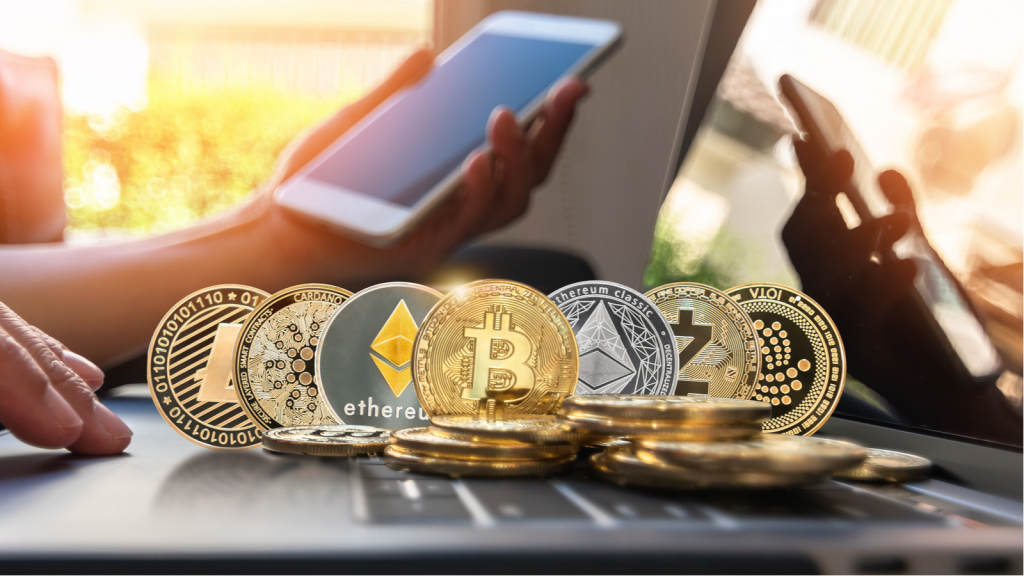
As decentralized assets that trade 24/7/365 irrespective of weekends, holidays and any other traditional cessation of business, cryptos represent the ultimate international indicator of investor sentiment.
In fact, the reaction to the ongoing Russia-Ukraine conflict earlier this week is a prime example. Specifically, Russian President Vladimir Putin made the incendiary move to recognize separatist-controlled Ukrainian territory as independent states on Presidents’ Day in the U.S. — a stock market holiday.
Therefore, those who were relying solely on American benchmarks such as the S&P 500 index had to wait another 24 hours to determine the impact Moscow’s belligerence had on the equities sector. But those who followed cryptos suffered no such delay. Indeed, I’ve personally gotten in a habit of monitoring the sector hour by hour.
If the sector tumbles as it did on Presidents Day, I know something’s up. Even if you don’t care for cryptos, digital assets have now become a barometer for critical global events.
Still, that leaves out an important question: where does the sector go from here? With western powers announcing sanctions for Russia sending “peacekeeping” forces into the aforementioned breakaway territories — with more punitive actions presumably on the way — the global economy could get awfully wobbly. Therefore, investors will want to exercise caution when assessing these cryptos to watch.
Though the present circumstances don’t look inviting — with some analysts suggesting the risk of stagflation if tensions in eastern Europe turn hot — it’s not out of the realm of possibility that cryptos could soar as a safe haven. Admittedly, I’m skeptical of this argument but investors should leave no stone unturned.
Cryptos to Watch: Bitcoin (BTC)
Source: kitti Suwanekkasit / Shutterstock.com
Throughout most of February, Bitcoin managed to trade above the critical $40,000 threshold. Though the Ukraine crisis dominated headlines, at the time, it appeared that world leaders were racing for a diplomatic solution. Without an explicitly aggressive overture from the Kremlin, a slimmer of hope existed that cooler heads would prevail.
Unfortunately, Putin decided to go the strongarm approach, recognizing the breakaway territories as sovereign lands: the so-called Donetsk People’s Republic and Luhansk People’s Republic regions of Ukraine. Of course, no other nation has recognized this unilateral action. Even China — a longstanding Russian ally — called for new negotiations and respect for territorial integrity prior to the latest flashpoint.
As soon as Putin took the above inflammatory action, Bitcoin stumbled sharply, suggesting that BTC and other cryptos will be dependent on how far the Russians want to push their luck. Though it’s possible that Bitcoin could rise as a safe-haven asset, I’m not so sure if it will.
With all due respect, it’s beginning to appear that the world economy is held hostage by one person’s desire for unfettered power. Such circumstances usually don’t end well.
Ethereum (ETH)

Source: Filippo Ronca Cavalcanti / Shutterstock.com
If Bitcoin is the proof of concept that virtual currencies can transact across borders independent of a centralized administrative authority, Ethereum is among the refined products that take this decentralized blockchain technology and integrate it into multiple applications, most notably smart contracts.
The underlying message of ETH is simple: if people can send digital coins and tokens to each other securely without the presence of an oversight agency, then other contractual relationships can flourish without third-party intermediaries like brokers and attorneys. Theoretically, then, cryptos can be the financial lifeblood of independent economies.
However, the geopolitical flashpoint in Ukraine imposed a rude awakening. While blockchain communities pride themselves on their independence, the valuation of their cryptos is very much dependent on centralized concerns — such as whether a war is about to erupt in Europe.
Thus, I don’t fall into the camp that investors of digital assets can ignore present geopolitical rumblings. If that were the case, you’d expect Ethereum and similar cryptos to be insulated from the volatility that has affected centralized markets. So, as with Bitcoin, a cautious approach is best.
Cryptos to Watch: XRP (XRP)

Source: Shutterstock
Prior to the erosion of geopolitical stability in eastern Europe, one of the biggest talking points for the virtual currency sector was XRP — the crypto coin and network introduced by Ripple Labs. Originally designed as an alternative to clunky and expensive bank wire transfers, XRP drew both intrigue and skepticism due to its somewhat centralized nature.
However, when the Securities and Exchange Commission (SEC) filed a lawsuit against Ripple. In this, the SEC alleged that Ripple used XRP as a means to sidestep securities laws. In turn, the crypto fanbase immediately rallied behind the company. However, should the SEC succeed in its case, it could have serious repercussions for other cryptos.
But as the legal proceedings went on, Ripple picked up a collection of small victories. Most recently, experts suggest that if the judge presiding over the lawsuit forces the disclosure of private emails, it could swing the needle in favor of Ripple.
If that happens, XRP could potentially be the only crypto with U.S. legal clarity. It’s still a risky narrative, but one speculators might consider and keep an eye on.
Cardano (ADA)

Source: Stanslavs / Shutterstock
While XRP just might rise above the muck due to potentially powerful catalysts uniquely benefitting it, the same can’t be said about Cardano. Week after week, I mentioned that ADA’s price action relative to key technical indicators was worrisome. If the coin didn’t swing higher and reassert itself, it risked scaring away the bulls.
Well, that looks to be what’s happening right now. After flirting with dangerous support lines, Cardano currently trades for 92 cents — conspicuously below the psychological level of $1. To be fair, Russia’s incursion into Ukraine lit the fuse, a circumstance beyond the blockchain project’s control. Still, the volatility confirms that cryptos are not immune to centralized concerns.
Therefore, the concept of a purely decentralized financial ecosystem is simply a technicality. Yes, coins and tokens can be exchanged without the need of an intermediary. But so what? If said coins and tokens are rendered worthless — or worth less — by outside factors, the decentralization element becomes a moot point: no one’s going to expend real energy costs to transmit deflating assets.
Cryptos to Watch: Solana (SOL)

Source: solvertv / Shutterstock.com
Judged purely on its technological merits, Solana presents itself as a compelling alternative to Ethereum. Faster, more scalable and just as secure as Ethereum, Solana commands another critical advantage: ultra-low transaction fees.
To put it simply, as Ethereum rose in popularity, it basically became too big for its britches. Transactions within the ETH network slowed to a crawl. Users could override this time penalty, but at the cost of extraordinarily high transaction fees called gas. With the expense becoming too onerous for many, Ethereum saw an exodus of developers to competing platforms — one of which was Solana.
Not surprisingly given this context, SOL rocketed higher last year, rapidly transitioning from a single-dollar asset to one that commanded a healthy three-digit price tag. However, Solana couldn’t overcome the negative implications of Russia’s invasion of Ukraine, leading to a dip below the $100 level.
In my view, investors should sit on the sidelines. Though SOL is fundamentally intriguing, its price tag is now well below its 50-day moving average (DMA) of $113.21 and 200 DMA of $151.65.
Polkadot (DOT)

Source: Zeedign.com / Shutterstock.com
Among the most intriguing cryptos, Polkadot was labeled an Ethereum killer last year due to its profound utility. Not only was the network fast and secure, but the underlying protocol also featured the ability to “connect public and private chains, permissionless networks, oracles and future technologies, allowing these independent blockchains to trustlessly share information and transactions through the Polkadot Relay Chain.”
If Bitcoin is a paved road and Ethereum a single-lane highway, Polkadot would be the equivalent of the interstate freeway system; Not only connecting drivers to multiple roadways but also providing several means to travel to other states. Essentially, the DOT network brought even more utility and engagement potential for the broader blockchain industry.
Still, like other cryptos, while the technical underpinnings of Polkadot may be independent from centralized control, the valuation of the DOT coin has not been free from centralized concerns.
Similar to the plight of other virtual currencies, DOT’s price of $16.96 is significantly below its 50 DMA of $21.16 and 200 DMA of $30.68. Because the tensions that brought us this mess in cryptos doesn’t show any sign of abating, I’d be careful about overexposure to Polkadot.
Cryptos to Watch: Chainlink (LINK)

Source: Stanslavs / Shutterstock.com
When I initially acquired a position in Chainlink, I was taken in by its remarkably simple but profound innovation. At its core, Chainlink leverages the power of decentralized oracle network technology to integrate off-chain information with blockchain-powered smart contracts.
As you know, most life transactions occur off-chain, such as buying real estate, filing a marriage certificate, registering your vehicle, whatever. Thus, developing a smart contract architecture would be deemed useless if it couldn’t access off-chain data to determine whether the terms of a contract were fulfilled or not.
In a way, Chainlink is the bridge between the digital realm and the real world, theoretically making it one of the most powerful innovations within digital assets since the invention of Bitcoin. Unfortunately, this fundamental catalyst has been proven wanting.
Since geopolitical hostilities have simmered, LINK has been looking vulnerable to a severe correction. What’s more, President Joe Biden’s administration responded with sweeping sanctions on a Russian bank, indicating that tensions will likely flare more. Thus, I’d stay away from Chainlink until the volatility subsides.
On the date of publication, Josh Enomoto held a LONG position in BTC, ETH, XRP, ADA and LINK. The opinions expressed in this article are those of the writer, subject to the InvestorPlace.com Publishing Guidelines.
A former senior business analyst for Sony Electronics, Josh Enomoto has helped broker major contracts with Fortune Global 500 companies. Over the past several years, he has delivered unique, critical insights for the investment markets, as well as various other industries including legal, construction management, and healthcare.
This news is republished from another source. You can check the original article here



